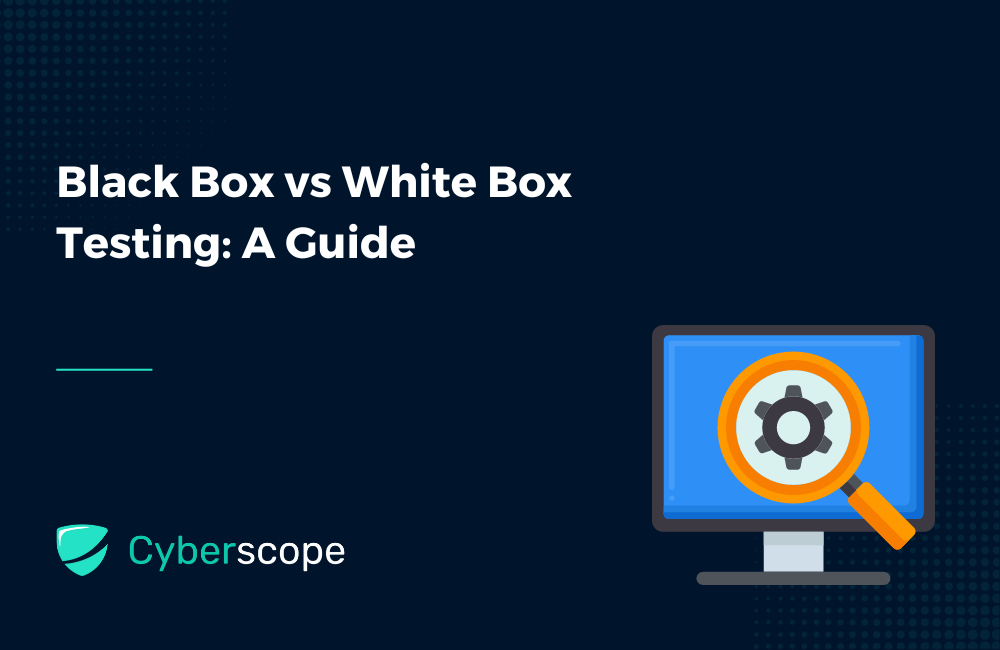.jpg%3Falt%3Dmedia&w=640&q=75)

Black Box vs White Box Testing: A Guide

Smart contract testing is an essential part of the development process to ensure the quality and functionality of a product. Two fundamental testing methodologies, Black Box Testing, and White Box Testing, play a pivotal role in identifying and rectifying defects. While both approaches aim to identify bugs and errors, they differ in their testing approach, the level of knowledge required from testers, and the extent of test coverage. In this article, we will delve into the differences between Black Box Testing and White Box Testing and how they impact the testing process and results.

What is Black Box Testing?
Definition of Black Box Testing
Black Box Testing is a smart contract testing technique where the tester has no knowledge of the internal structure or workings of the system being tested. The tester treats the system as a black box, focusing solely on the inputs and outputs without any understanding of how the system processes the inputs or produces the outputs. This approach allows for testing the functionality and behavior of the system from the perspective of an end user.
Black Box Testing is often used to validate the system against specified requirements and to ensure that it meets the expected functionality. It is particularly useful for testing complex systems where the internal workings are too complex or not accessible to the tester. By treating the system as a black box, the tester can focus on testing the system's external behavior and ensure that it performs as expected.
There are several advantages to using Black Box Testing. First, it allows for testing the system from the perspective of an end user, which helps to identify any usability issues or user experience problems. Second, it provides a way to validate the system against specified requirements and ensure that it meets the expected functionality. Third, it can be used to test the system's compatibility with different platforms and environments. Finally, Black Box Testing can be performed without any knowledge of the system's internal structure, making it suitable for testing third-party smart contract or components.
However, there are also some disadvantages to using Black Box Testing. One disadvantage is that it may not uncover all possible defects or vulnerabilities in the system. Since the tester does not know the internal workings, they may miss certain edge cases or scenarios that could lead to failures. Additionally, Black Box Testing can be time-consuming and require a significant amount of test cases to cover all possible inputs and outputs. Finally, it may be difficult to determine the root cause of a failure or issue since the tester has limited visibility into the internal workings of the system.
Advantages of Black Box Testing
Black Box Testing is a user-centric approach that mimics the end-user experience. Testers interact with the application's user interface and provide inputs to observe the corresponding outputs. The goal is to validate that the smart contract performs as expected, irrespective of its internal implementation. This approach offers several advantages:
- User-Centric: Black Box Testing ensures that the smart contract meets user expectations by focusing on the end-user experience. It allows testers to evaluate the smart contract from the perspective of an external user.
- No Code Knowledge Required: Testers don't need to know the internal codebase. This allows for an unbiased evaluation of the smart contract's functionality and behavior.
- Effective for System Testing: Black Box Testing is ideal for validating the integration of various components within a system. It helps identify any issues or inconsistencies in the interactions between different modules or subsystems.
- Improved Product Quality: By thoroughly testing the smart contract from a user's perspective, Black Box Testing contributes to overall product quality. It helps uncover usability issues, functional defects, and other issues that may impact the user experience.
- Defect Fixing: Black Box Testing gives developers more time for defect fixing. Since testers focus on the smart contract's external behavior, they can identify and report defects that need to be addressed by the development team.
It is important to note that Black Box Testing has its limitations. For example, it may not be suitable for algorithm validation or testing internal code logic. However, it is a valuable testing approach that provides insights into the smart contract's functionality and user experience.
Disadvantages of Black Box Testing
Black box testing, while valuable in many scenarios, also has its limitations and drawbacks. One of the main disadvantages of black box testing is the lack of visibility into the internal workings of the system being tested. Testers who perform black box testing do not have access to the source code or the internal structure of the application. This limited access can make it challenging to identify certain types of defects or vulnerabilities that may be present.
Another disadvantage of black box testing is the reliance on input-output analysis. Testers focus on the inputs provided to the system and analyze the outputs generated, without considering the internal logic or implementation details. While this approach allows for a more realistic assessment of the system's behavior from an end-user perspective, it may miss certain defects that can only be identified through a deeper understanding of the internal workings.
Additionally, black box testing can be time-consuming and resource-intensive. Testers need to thoroughly explore the system's functionality and test various input combinations to ensure comprehensive coverage. This can require a significant amount of time and effort, especially for complex applications. Furthermore, the lack of knowledge about the internal structure can lead to inefficient test design and redundant test cases, resulting in wasted resources.
It is important to note that black box testing may not be suitable for all types of applications. For example, applications that heavily rely on complex algorithms or require in-depth knowledge of the internal logic may benefit more from white box testing. Black box testing may also have limitations in detecting certain types of vulnerabilities, such as those related to the security of the underlying code.

What is White Box Testing?
Definition of White Box Testing
White box testing, also known as clear box testing or glass box testing, is a method where the internal workings of an application are examined. It involves understanding how the smart contract is structured and using that knowledge to design the test cases. This technique is often used for unit testing, ensuring that all code paths are tested thoroughly. White box testing emphasizes code structure and logic.
Techniques Used in White Box Testing:
- Statement coverage: This technique ensures that each statement in the code is executed at least once during testing.
- Decision coverage: This technique ensures that all possible decision outcomes are tested.
- Path coverage: This technique aims to test all possible paths through the code, including loops and conditional statements.
Advantages of White Box Testing
One of the key benefits is thorough coverage of code paths, ensuring a more exhaustive examination. By scrutinizing the code, testers can uncover hidden errors and defects at the code level, enabling early rectification. This early detection of bugs leads to better-quality smart contract. Another advantage is the ability to optimize and refine the source code for better performance. Testers can analyze the code and identify areas for improvement, resulting in optimized code that enhances the overall smart contract performance and reliability. Additionally, white box testing provides insight into the design and implementation of the smart contract. Testers gain a deeper understanding of how the smart contract works internally, allowing for better maintenance and troubleshooting. Overall, the advantages of white box testing include thorough coverage, early bug detection, code optimization, and an improved understanding of the smart contract's internals.
Disadvantages of White Box Testing
While white box testing can be a useful tool for ensuring the quality of smart contract, it also has its drawbacks. White box testing requires a significant amount of time and effort to design and execute test cases that cover all code paths. That makes it a highly time-consuming method of testing. Since white-box testing focuses on the internal structure of the smart contract, it may overlook certain aspects that can only be identified through black-box testing. White box testing also requires testers to have a good understanding of programming languages and code structure to effectively design and execute test cases.

Key Differences Between Black Box Testing and White Box Testing
Approach
White Box Testing focuses on analyzing the internal workings and paths of the smart contract. It involves inspecting the source code thoroughly to identify any potential issues or bugs. The goal is to achieve thorough testing coverage by ensuring that all possible paths in the code are tested. This approach requires a deep understanding of the smart contract specifications and functionalities. On the other hand, Black Box Testing focuses on the external behavior and user interactions of the smart contract. It does not require programming knowledge and may not cover all internal paths explicitly. The emphasis is on detailed and thorough coverage of the smart contract's functionality.
Level of Knowledge
In white box testing, the tester has a high level of knowledge about the internal workings of the system being tested. This means that the tester has access to the source code, architecture, and design of the system. With this level of knowledge, the tester can analyze the code and identify potential vulnerabilities or weaknesses. They can also understand the flow of data within the system and ensure that it is handled correctly. This deep understanding of the system allows the tester to create targeted test cases that cover specific areas of the code or functionality.
On the other hand, in black box testing, the tester has a limited level of knowledge about the internal workings of the system. They do not have access to the source code or detailed information about the system's architecture. Instead, they approach the system as an external user would, with only knowledge of the system's inputs and expected outputs. This means that the tester focuses on testing the system's functionality and ensuring that it meets the specified requirements.
To illustrate the difference in level of knowledge, let's consider an example. Imagine a smart contract application that processes financial transactions. In white box testing, the tester would have access to the source code and could analyze how the application handles sensitive financial data. They could identify potential security vulnerabilities and ensure that the application follows best practices for handling such data. In black box testing, the tester would not have access to the source code and would focus on testing the application's functionality, such as ensuring that transactions are processed correctly and that the user interface is intuitive.
In summary, the level of knowledge in white box testing is high, allowing the tester to analyze the internal workings of the system and create targeted test cases. In black-box testing, the level of knowledge is limited, and the focus is on testing the system's functionality from an external perspective.
Test Design
Test design is a crucial aspect of smart contract testing that involves creating test cases and test scenarios to ensure comprehensive coverage of the system under test. It is the process of determining what to test, how to test, and what the expected results should be. Effective test design is essential for identifying defects and ensuring the quality of the smart contract.
Test design involves various techniques and methodologies to ensure that all aspects of the system are thoroughly tested. One commonly used technique is boundary value analysis, which focuses on testing the boundaries of input values. By testing both the lower and upper limits of valid and invalid inputs, testers can identify potential issues and ensure that the system behaves as expected.
Another technique used in test design is equivalence partitioning, which involves dividing the input domain into classes of equivalent values. This technique helps reduce the number of test cases while still ensuring adequate coverage of different input scenarios.
In addition to these techniques, test design also considers factors such as test prioritization, test data generation, and test case optimization. Test prioritization involves determining the order in which tests should be executed based on their importance and potential impact on the system. Test data generation focuses on creating test data that covers a wide range of scenarios and edge cases. Test case optimization aims to minimize the number of test cases while maximizing their effectiveness.
To ensure effective test design, testers need to have a deep understanding of the system under test and its requirements. This knowledge allows testers to identify critical areas that require thorough testing and prioritize their efforts accordingly. Testers should also consider the different levels of testing, such as unit testing, integration testing, and system testing, and design test cases that address the specific requirements of each level.
In summary, test design is a critical phase of smart contract testing that involves creating test cases and scenarios to ensure comprehensive coverage of the system under test. It involves various techniques and methodologies to identify defects and ensure the quality of the smart contract. Testers should have a deep understanding of the system and its requirements to design effective test cases that address the specific needs of each level of testing.
Test Coverage
Test coverage is a critical aspect of smart contract testing. It refers to the extent to which the code of a smart contract application is tested by a set of test cases. The goal of test coverage is to ensure that all parts of the code are exercised and that potential defects are identified and fixed. There are several techniques used to measure test coverage, including statement coverage, branch coverage, condition coverage, and path coverage.
When to Use Black Box Testing?
Scenarios for Black Box Testing
Black Box Testing, also known as Functional Testing, focuses on evaluating the smart contract’s functionality without any knowledge of its internal workings. Testers approach the smart contract as an external user, interacting with the application’s user interface and providing inputs to observe the corresponding outputs. The goal is to validate that the smart contract performs as expected, irrespective of its internal implementation.
Advantages of Black Box Testing:
- User-Centric: Mimics end-user experience, ensuring the smart contract meets user expectations.
- No Code Knowledge Required: Testers don’t need knowledge of the internal codebase, allowing for an unbiased evaluation.
- Effective for System Testing: Ideal for validating the integration of various components in the system.
Example of Black Box Testing:
Continuing with the banking application example, Black Box Testing involves assessing the smart contract by inputting various scenarios, such as creating a new account, making transactions, and checking balances. The focus is on ensuring that the user interactions result in the expected outcomes.
When to Use White Box Testing?
Scenarios for White Box Testing
White box testing is a smart contract testing technique that focuses on examining the internal structure and code of a smart contract application. It is particularly useful in scenarios where a deep understanding of the code is required to ensure thorough testing and identify potential issues. Testers who perform white box testing have access to the internal codebase, allowing for an unbiased evaluation. This technique is effective for system testing, as it helps validate the integration of various components in the system.
One example of white box testing is in the context of a banking application. Testers may scrutinize the code that calculates interest rates based on various parameters to ensure that the interest calculation formula is correctly implemented. By examining the code, testers can verify that the calculations are accurate and that the application behaves as expected.
White box testing offers several advantages. First, it provides thorough coverage of code paths, ensuring a more exhaustive examination. This comprehensive testing helps identify hidden errors that may not be apparent through other testing techniques. Additionally, white box testing helps optimize and refine the source code for better performance. By analyzing the code, testers can identify areas for improvement and make necessary optimizations. Early detection of bugs is another advantage of white-box testing. By examining the code level, testers can identify defects early in the development process, enabling prompt rectification and reducing the impact on later stages of the smart contract development life cycle.
When conducting white box testing, it is important to focus on creating test cases that exercise all aspects of the code, including loops, conditions, and branches. This ensures comprehensive test coverage and increases the likelihood of uncovering hidden errors. Testers should also consider different white box testing techniques, such as code coverage analysis, to eliminate gaps in the test case suite and identify areas of the program that are not exercised by the existing test cases.

Benefits of Black Box and White Box Testing
By doing both Black and White Box Testing, we get Gray Box Testing. By doing gray box testing, the benefits of both black box and white box testing are obtained. Specifically:
- Unbiased: Gray box testing is unbiased. It avoids conflicts between a tester and a developer.
- Effective testing: Gray box testing is much more effective in integration testing. Clarity of goals: Users and developers have clear goals while doing testing.
- Done from the user perspective: Gray box testing is mostly done by the testers from the user's perspective.
- High programming skills not required: Testers are not required to have high programming skills for this testing.
- Improved product quality: The overall quality of the product is improved. Defect fixing: In gray box testing, developers have more time for defect fixing.
- Benefits of black box and white box testing: By doing gray box testing, the benefits of both black box and white box testing are obtained.
- Effective testing: Gray box testing is much more effective in uncovering hidden errors.
Conclusion
In conclusion, understanding the differences between white box testing and black box testing is crucial for smart contract development teams to implement an effective testing strategy. Both approaches have their advantages and disadvantages, and the choice between them depends on the testing objectives, project requirements, and the stage of the development lifecycle. Integrating both methodologies ensures a balanced and comprehensive approach to smart contract testing, resulting in a robust and reliable final product. Employing an experienced company to assist you with your testing is essential. Having an unbiased third party in control of your testing can play a pivotal role in getting the best results for the optimization and security of your project.
Recent Posts
.jpg%3Falt%3Dmedia&w=640&q=75)


What is a Fallback Attack in Smart Contracts?
6 months ago
